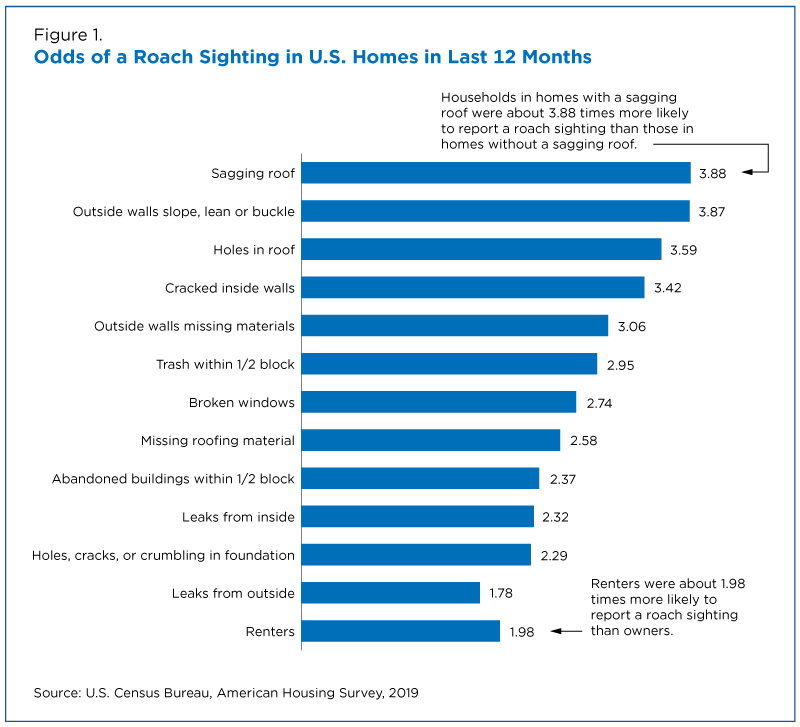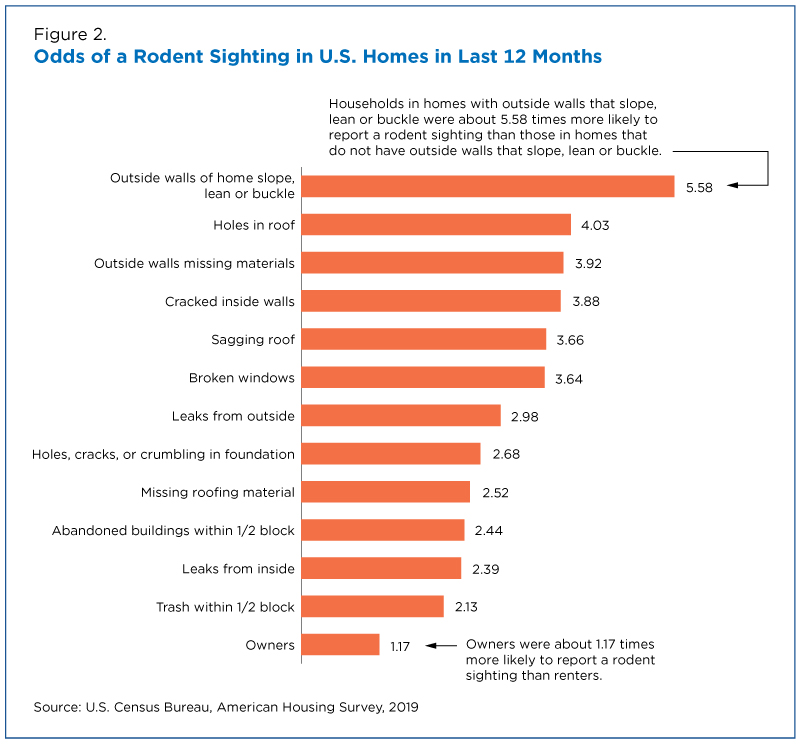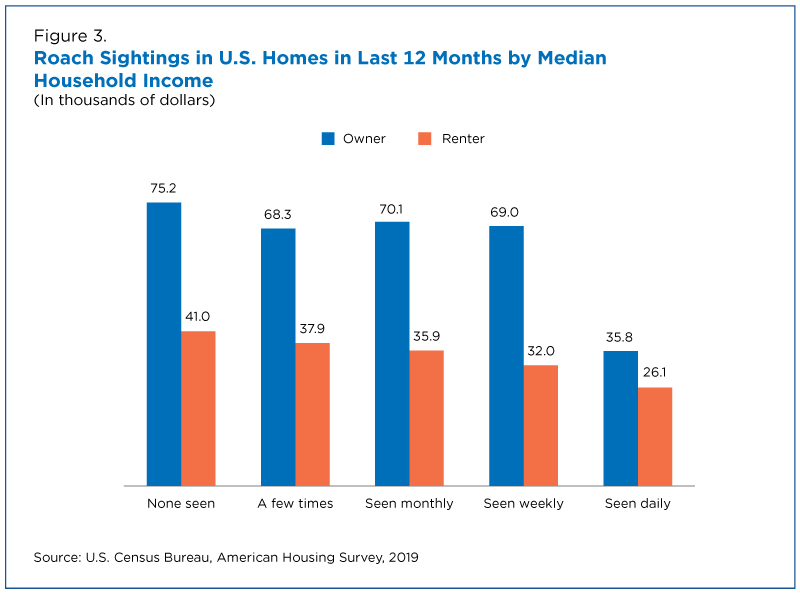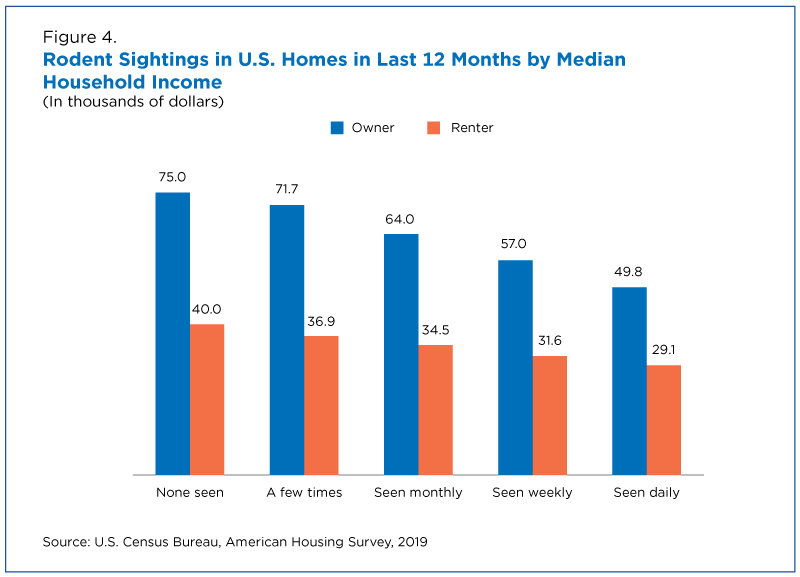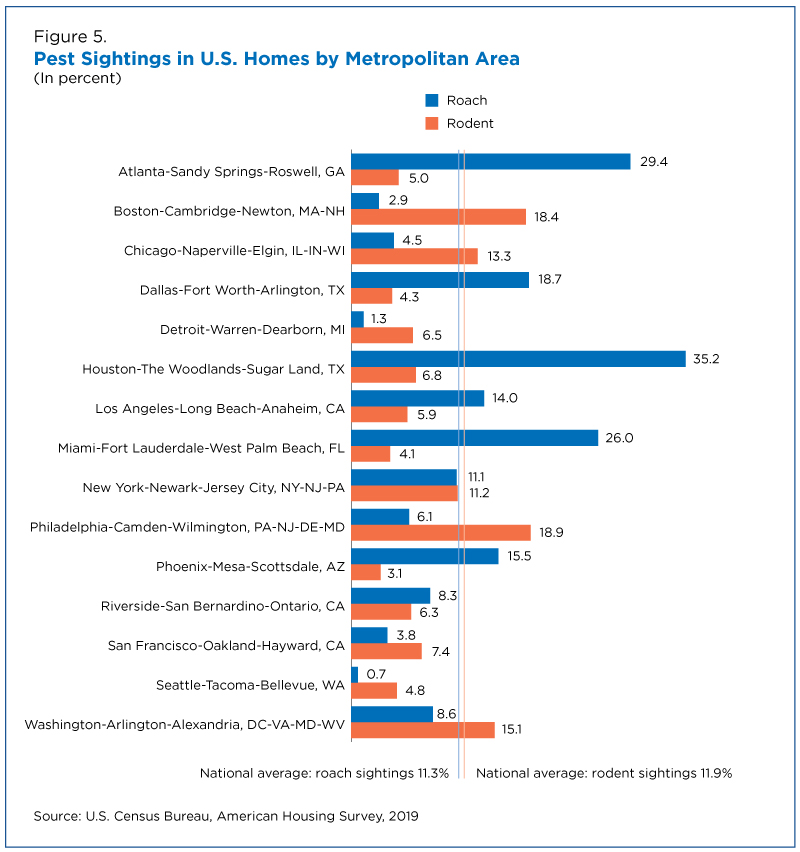Residents of 14 Million Housing Units Reported Seeing Roaches, 14.8 Million Saw Rodents in Last 12 Months
Pests are a problem in housing units across the country but are most prevalent among households with lower incomes and in housing units with structural problems and water leaks.
The presence of pests raises public health concerns and data show that about 14 million of the approximately 124 million occupied housing units in the United States reported seeing roaches in their homes during the last 12 months. Also, nearly 14.8 million reported seeing rodents (mice or rats).
Neighborhood characteristics such as being within half a block of trash or an abandoned building are also associated with a higher likelihood of reporting pests.
About 2.9 million reported sightings of both roaches and rodents in their homes, according to the 2019 American Housing Survey (AHS).
Sponsored by the U.S. Department of Housing and Urban Development (HUD) and conducted by the U.S. Census Bureau, the American Housing Survey (AHS) is the most comprehensive national housing survey in the United States.
The AHS collects indicators of housing quality, including questions about how often (daily, weekly, monthly or a few times) people in household saw signs of cockroaches or rodents in the home in the last 12 months. The questions also include seeing traces of cockroaches (feces) and rodents (droppings or ripped food containers).
The survey points to differences between homeowners and renters and between geographic locations. Roaches are more common in renter-occupied units and units in the South, while rodents are more common in owner-occupied units and units in the Northeast.
Health Concerns
A typical home includes many species of insects, but cockroaches are especially well adapted to living with humans. According to the Environmental Protection Agency, they can trigger asthma and other health concerns. Roaches filter in from the outdoors through cracks and crevices and are attracted to food.
The Centers for Disease Control and Prevention (CDC) reports that rats and mice may spread diseases to humans directly through feces, urine or saliva, and indirectly through ticks, mites or fleas that have fed on an infected rodent. Rodents are attracted to trash outside of homes and dark, moist places in which they can burrow, such as lumber or firewood stored outside of homes.
Pests Thrive in Homes With Structural Problems
Roaches and rodents aren’t the only quality issues households experience. Structural problems such as cracked walls, broken windows and leaks are also frequent problems and often create the conditions that lead to pests.
The likelihood of sighting a roach was higher in homes with structural problems and in renter-occupied units (Figure 1). For example, homes with a sagging roof were about 3.9 times more likely than homes without a sagging roof to have roach sightings.
Residents of owner-occupied units and homes with structural problems were more likely to report seeing a rodent in the last 12 months (Figure 2). For example, homes with outside walls that slope, lean, or buckle were about 5.6 times more likely than those without these structural wall problems to have rodent sightings.
Neighborhood characteristics such as being within half a block of trash or an abandoned building are also associated with a higher likelihood of reporting pests.
Income Makes a Difference
Frequency of pest sightings by income level vary for both owner- and renter-occupied housing units.
Home owners who reported weekly roach sightings had a median annual household of $69,000 compared to $35,800 for those reporting daily sightings (Figure 3).
The median income difference between renters’ weekly and daily sightings was smaller — $32,000 and $26,100, respectively.
There was not a statistically significant difference in income between renters and owners who reported weekly and daily rodent sightings. But the income difference between seeing rodents “a few times” and “daily” in the last 12 months were statistically different for both owners and renters (Figure 4).
Roach and Rodent Sightings by Metro Area
The frequency of pest sightings for the 15 most populated metropolitan areas are shown in Figure 5. The vertical bars show national averages for pest sightings: roach sightings (11.3% of households) were less prevalent than rodent sightings (11.9%).
There was significant variation across these areas, particularly with roaches. The Seattle-Tacoma-Bellevue metro area reported the lowest percentage of roach sightings at around 0.7% while the Houston-The Woodlands-Sugar Land metro area reported the most at 35.2%.
The Phoenix metropolitan area has the nation’s lowest percentage of rodent sightings at 3.1%, though the percentage in Miami (4.1%) was not statistically different. The Philadelphia metropolitan area had the highest rodent sightings at 18.9%, though the percentage in the Boston area was not statistically different from Philadelphia.
Pests pose a problem no matter where one lives and are an often-overlooked public health concern. AHS results give policy makers the tools to craft and target evidence-based policy and programs to improve housing standards and public health. More information about health concerns caused by pests and how to lower risk of pest-related health problems can be found in the CDC’s Healthy Housing Reference Manual.
Information on sampling error, nonsampling error and definitions is available on the 2019 American Housing Survey’s technical documentation page.
Michael Sellner and Jordan Wicht are survey statisticians in the American Housing Survey Branch.
Redistricting & Voting Rights Data Office (RDO)
Visualizations
2020 Census Demographic Data Map Viewer is a web map application that includes state-, county-, and census tract-level data from the 2020 Census.
Data
Fact Sheets
Blog Posts
Newsroom
Census Academy
View training resources for 2020 Census data.
Videos
Maps
-
2020 Census Demographic Data Map ViewerThe 2020 Census Demographic Data Map Viewer is web map application that includes state, county, and tract-level data from the 2020 Census.
-
2020 Census P.L. 94-171 Redistricting Data Map SuiteHere you will find the 2020 Census P.L. 94-171 Redistricting Data Map Suite
-
TIGER/Line ShapefilesView all the available mapping files from the Geography program.
Story Ideas and Statistics
-
Stats for StoriesAmerican Housing Month: June 2023The 2021 American Community Survey counted 142.15M housing units, up 3.61M from 2018, and up 10.36M from 131.79M in 2010.
-
American Housing Survey (AHS)The AHS is sponsored by the Department of Housing and Urban Development (HUD) and conducted by the U.S. Census Bureau.
Subscribe
Our email newsletter is sent out on the day we publish a story. Get an alert directly in your inbox to read, share and blog about our newest stories.
Contact our Public Information Office for media inquiries or interviews.
-
America Counts StoryWere American Homes Ready for the Pandemic?April 13, 2021Isolating when someone is infected with COVID-19 is challenging when 38% of U.S. multi-person households don’t have two bathrooms and enough bedrooms.
-
America Counts StoryOld Housing, New NeedsJune 22, 2020Only 10% of homes in the U.S. are aging-ready, while a quarter of all older households have trouble using some of the features of their home.
-
America Counts StoryNew Apartment Construction Declined Nationwide between 2017 and 2019March 18, 2021The Census Bureau’s Survey of Market Absorption of New Multifamily Units provides information on new apartment construction and rental costs.
-
EmploymentThe Stories Behind Census Numbers in 2025December 22, 2025A year-end review of America Counts stories on everything from families and housing to business and income.
-
Families and Living ArrangementsMore First-Time Moms Live With an Unmarried PartnerDecember 16, 2025About a quarter of all first-time mothers were cohabiting at the time of childbirth in the early 2020s. College-educated moms were more likely to be married.
-
Business and EconomyState Governments Parlay Sports Betting Into Tax WindfallDecember 10, 2025Total state-level sports betting tax revenues has increased 382% since the third quarter of 2021, when data collection began.
-
EmploymentU.S. Workforce is Aging, Especially in Some FirmsDecember 02, 2025Firms in sectors like utilities and manufacturing and states like Maine are more likely to have a high share of workers over age 55.

